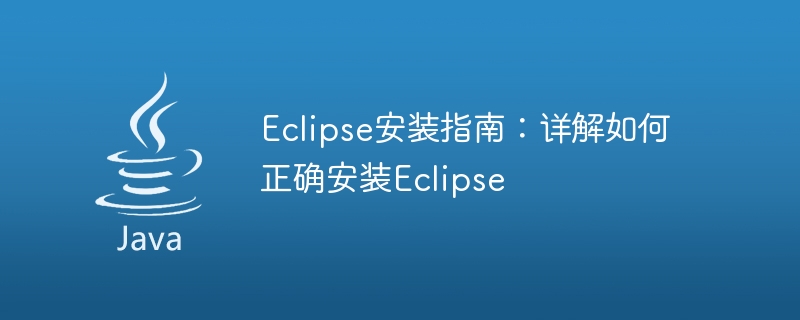
Eclipse Installation Guide: Detailed explanation of how to install Eclipse correctly, specific code examples are required
Introduction:
Eclipse is a very powerful and popular integrated development environment (IDE), is widely used in the development of various programming languages. This article will introduce in detail how to install Eclipse correctly and provide some sample code to help readers use this powerful development tool smoothly.
1. Download Eclipse:
- Open the Eclipse official website (https://www.eclipse.org/) and select the latest version of Eclipse.
- According to your operating system, select the corresponding Eclipse version to download. If your computer is 64-bit, it is recommended to choose the 64-bit Eclipse version to provide better performance.
- Choose the appropriate download link to download.
2. Install Eclipse:
- Extract the downloaded Eclipse compressed file to the directory you want to install. We recommend installing Eclipse in a directory without special permission restrictions for subsequent use and updates.
- Open the decompressed Eclipse folder, find the "eclipse.exe" or "eclipse" executable file, and double-click to run it.
- On first run, Eclipse will ask you to select a workspace. The workspace is where Eclipse stores your projects and settings. Select a directory you like as your workspace and click the "OK" button.
3. Configure Eclipse:
- After opening Eclipse, first configure the JDK path. Click "Window" -> "Preferences" on the menu bar.
- In the pop-up dialog box, select "Java" -> "Installed JREs".
- Click the "Add" button, select the JDK folder you have installed, and click the "OK" button.
- In the same dialog box, click the "Compiler" tab and make sure the correct JDK is selected.
- Click the "Apply and Close" button to save and close the dialog box.
4. Create and run the project:
- In the Eclipse workspace, right-click the Package Explorer view (the navigation panel on the left) and select "New " -> "Java Project".
- Enter the name of the project and click the "Finish" button.
- Right-click the project name in Package Explorer and select "New" -> "Class".
- Enter the name of the class, select a package, and click the "Finish" button.
- Write your Java code in the editing area and save the file.
- Click the "Run" -> "Run" button in the menu bar to run your Java code.
Sample code:
The following is a simple sample code that demonstrates how to create a Hello World program in Eclipse.
public class HelloWorld {
public static void main(String[] args) {
System.out.println("Hello, World!");
}
}Copy after login
Please note that this is just a simple sample code, you can write more complex code to use Eclipse according to your needs.
Conclusion:
Through this article, we have introduced in detail how to install Eclipse correctly and provided a simple sample code to help readers get started. I hope readers can use Eclipse smoothly and discover its powerful functions and conveniences in the development process. Any new development tool requires our patience to learn and master it. I hope this guide will be helpful to you. I wish you a happy development project using Eclipse!
The above is the detailed content of Eclipse installation steps: A complete guide to teach you how to install Eclipse correctly. For more information, please follow other related articles on the PHP Chinese website!






